美国文学史及选读教案
- 格式:doc
- 大小:320.50 KB
- 文档页数:64
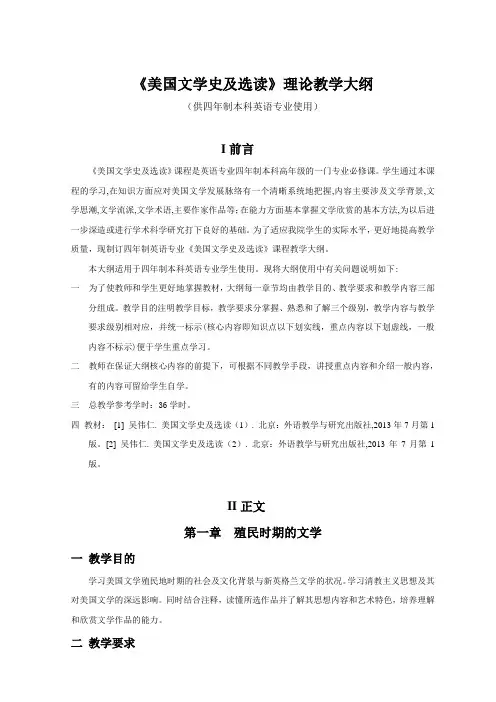
《美国文学史及选读》理论教学大纲(供四年制本科英语专业使用)I前言《美国文学史及选读》课程是英语专业四年制本科高年级的一门专业必修课。
学生通过本课程的学习,在知识方面应对美国文学发展脉络有一个清晰系统地把握,内容主要涉及文学背景,文学思潮,文学流派,文学术语,主要作家作品等;在能力方面基本掌握文学欣赏的基本方法,为以后进一步深造或进行学术科学研究打下良好的基础。
为了适应我院学生的实际水平,更好地提高教学质量,现制订四年制英语专业《美国文学史及选读》课程教学大纲。
本大纲适用于四年制本科英语专业学生使用。
现将大纲使用中有关问题说明如下:一为了使教师和学生更好地掌握教材,大纲每一章节均由教学目的、教学要求和教学内容三部分组成。
教学目的注明教学目标,教学要求分掌握、熟悉和了解三个级别,教学内容与教学要求级别相对应,并统一标示(核心内容即知识点以下划实线,重点内容以下划虚线,一般内容不标示)便于学生重点学习。
二教师在保证大纲核心内容的前提下,可根据不同教学手段,讲授重点内容和介绍一般内容,有的内容可留给学生自学。
三总教学参考学时:36学时。
四教材:[1] 吴伟仁. 美国文学史及选读(1). 北京:外语教学与研究出版社,2013年7月第1 版。
[2] 吴伟仁. 美国文学史及选读(2). 北京:外语教学与研究出版社,2013年7月第1版。
II正文第一章殖民时期的文学一教学目的学习美国文学殖民地时期的社会及文化背景与新英格兰文学的状况。
学习清教主义思想及其对美国文学的深远影响。
同时结合注释,读懂所选作品并了解其思想内容和艺术特色,培养理解和欣赏文学作品的能力。
二教学要求(一) 熟悉殖民地时期文学的特点。
(二) 掌握清教主义思想及其对美国文学的深远影响。
(三) 了解新英格兰文学。
三教学内容(一)殖民时期文学概述(二)清教主义思想(三)新英格兰文学第二章理性和革命时期的文学一教学目的学习理性和革命时期美国文学产生的社会及文化背景。
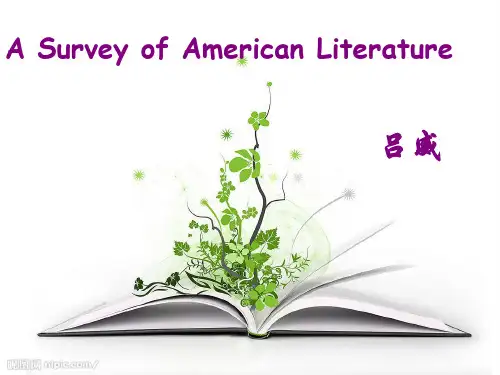
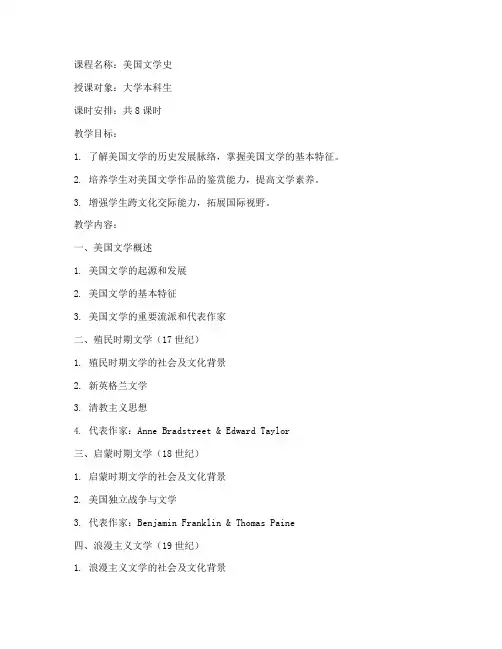
课程名称:美国文学史授课对象:大学本科生课时安排:共8课时教学目标:1. 了解美国文学的历史发展脉络,掌握美国文学的基本特征。
2. 培养学生对美国文学作品的鉴赏能力,提高文学素养。
3. 增强学生跨文化交际能力,拓展国际视野。
教学内容:一、美国文学概述1. 美国文学的起源和发展2. 美国文学的基本特征3. 美国文学的重要流派和代表作家二、殖民时期文学(17世纪)1. 殖民时期文学的社会及文化背景2. 新英格兰文学3. 清教主义思想4. 代表作家:Anne Bradstreet & Edward Taylor三、启蒙时期文学(18世纪)1. 启蒙时期文学的社会及文化背景2. 美国独立战争与文学3. 代表作家:Benjamin Franklin & Thomas Paine四、浪漫主义文学(19世纪)1. 浪漫主义文学的社会及文化背景2. 美国南北战争与文学3. 代表作家:Nathaniel Hawthorne & Edgar Allan Poe五、现实主义文学(19世纪末至20世纪初)1. 现实主义文学的社会及文化背景2. 代表作家:Mark Twain & Henry James六、现代主义文学(20世纪)1. 现代主义文学的社会及文化背景2. 代表作家:F. Scott Fitzgerald & Ernest Hemingway七、后现代主义文学(20世纪后半叶)1. 后现代主义文学的社会及文化背景2. 代表作家:Thomas Pynchon & Don DeLillo八、当代美国文学1. 当代美国文学的社会及文化背景2. 代表作家:Toni Morrison & John Updike教学过程:一、导入1. 结合美国历史背景,简要介绍美国文学的起源和发展。
2. 引导学生关注美国文学的基本特征和重要流派。
二、讲授1. 按照教学内容,依次讲解各个时期的美国文学。
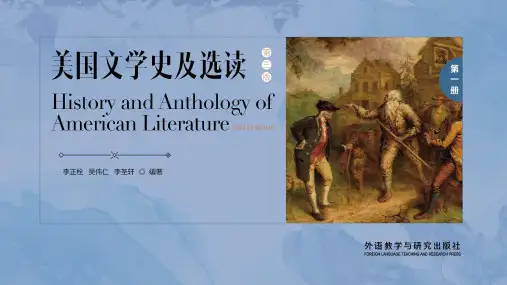
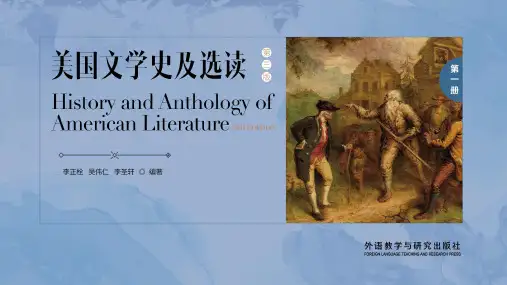
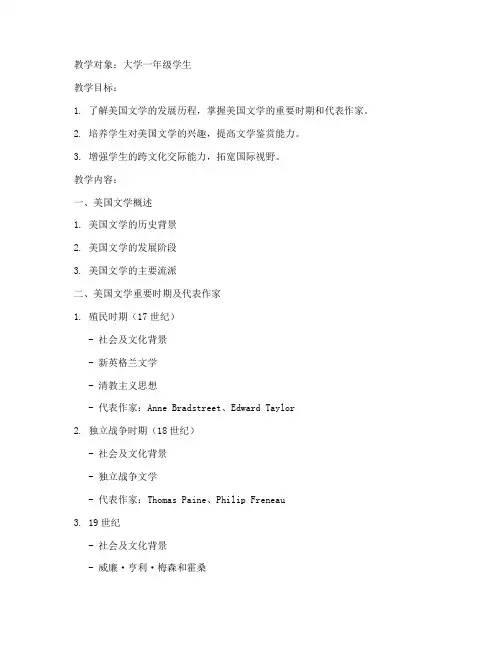
教学对象:大学一年级学生教学目标:1. 了解美国文学的发展历程,掌握美国文学的重要时期和代表作家。
2. 培养学生对美国文学的兴趣,提高文学鉴赏能力。
3. 增强学生的跨文化交际能力,拓宽国际视野。
教学内容:一、美国文学概述1. 美国文学的历史背景2. 美国文学的发展阶段3. 美国文学的主要流派二、美国文学重要时期及代表作家1. 殖民时期(17世纪)- 社会及文化背景- 新英格兰文学- 清教主义思想- 代表作家:Anne Bradstreet、Edward Taylor2. 独立战争时期(18世纪)- 社会及文化背景- 独立战争文学- 代表作家:Thomas Paine、Philip Freneau3. 19世纪- 社会及文化背景- 威廉·亨利·梅森和霍桑- 批判现实主义文学- 代表作家:Nathaniel Hawthorne、Harriet Beecher Stowe4. 20世纪- 社会及文化背景- 现实主义文学- 超现实主义文学- 代表作家:Ernest Hemingway、F. Scott Fitzgerald、T.S. Eliot教学方法:1. 讲授法:教师系统讲解美国文学的发展历程、重要时期和代表作家。
2. 讨论法:组织学生围绕美国文学的发展、流派和代表作家进行讨论。
3. 案例分析法:选取具有代表性的作品,引导学生分析其文学价值和社会意义。
4. 角色扮演法:让学生扮演美国文学中的重要人物,感受他们的思想感情。
教学过程:一、导入1. 向学生介绍美国文学的重要性,激发学生的兴趣。
2. 提出问题:美国文学是如何发展起来的?有哪些重要时期和代表作家?二、美国文学概述1. 讲解美国文学的历史背景和发展阶段。
2. 介绍美国文学的主要流派。
三、美国文学重要时期及代表作家1. 殖民时期:介绍社会及文化背景、新英格兰文学、清教主义思想,以及代表作家Anne Bradstreet和Edward Taylor。
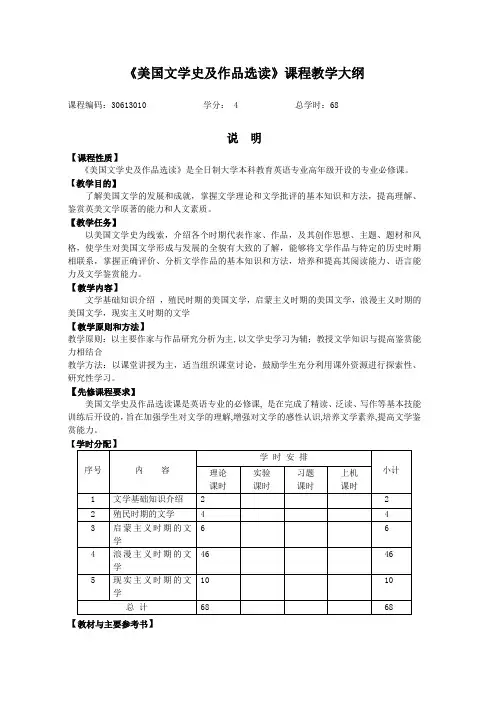
《美国文学史及作品选读》课程教学大纲课程编码:30613010 学分: 4 总学时:68说明【课程性质】《美国文学史及作品选读》是全日制大学本科教育英语专业高年级开设的专业必修课。
【教学目的】了解美国文学的发展和成就,掌握文学理论和文学批评的基本知识和方法,提高理解、鉴赏英美文学原著的能力和人文素质。
【教学任务】以美国文学史为线索,介绍各个时期代表作家、作品,及其创作思想、主题、题材和风格,使学生对美国文学形成与发展的全貌有大致的了解,能够将文学作品与特定的历史时期相联系,掌握正确评价、分析文学作品的基本知识和方法,培养和提高其阅读能力、语言能力及文学鉴赏能力。
【教学内容】文学基础知识介绍,殖民时期的美国文学,启蒙主义时期的美国文学,浪漫主义时期的美国文学,现实主义时期的文学【教学原则和方法】教学原则:以主要作家与作品研究分析为主,以文学史学习为辅;教授文学知识与提高鉴赏能力相结合教学方法:以课堂讲授为主,适当组织课堂讨论,鼓励学生充分利用课外资源进行探索性、研究性学习。
【先修课程要求】美国文学史及作品选读课是英语专业的必修课, 是在完成了精读、泛读、写作等基本技能训练后开设的,旨在加强学生对文学的理解,增强对文学的感性认识,培养文学素养,提高文学鉴赏能力。
【教材与主要参考书】教材:吴伟仁《美国文学史及选读》外语教学与研究出版社,1990年。
参考书:吴定柏《美国文学大纲》上海外语教育出版社, 1905年。
常耀信《美国文学简史》南开大学出版社, 1990年。
胡荫桐《美国文学教程》南开大学出版社, 2001年。
大纲内容第一部分文学基础知识介绍【教学目的和要求】教学目的:了解文学的基本知识教学要求:掌握文学的基本要素【内容提要】第一节文学的定义及研究对象第二节文学的基本要素第三节学习文学的目的和方法第四节美国文学历史简介【教学重点与难点问题】教学重点:文学的基本概念和要素及其区别和联系教学难点:美国文学的形成及发展【复习思考题】1.什么是文学?2.文学的基本分类和要素有哪些?3.美国文学主要分为哪几个发展阶段?第二部分殖民地时期的文学【教学目的和要求】教学目的:介绍殖民地时期的社会及文化背景与新英格兰文学的状况教学要求:理解清教主义思想及其对美国文学的深远影响【内容提要】第一节美国殖民地时期概述一、北美拓殖的开始二、美国清教主义思想三、美国清教主义思想对早期美国文学的影响第二节殖民地时期的代表作家及作品一、安妮•布雷兹特里特(Anne Bradstreet)二、爱德华•泰勒(Edward Taylor)【教学重点与难点问题】教学重点:殖民地时期新英格兰文学的特点教学难点:清教主义思想【复习思考题】殖民时期新英格兰文学的主要特点是什么?第三部分理性和革命时期的文学【教学目的和要求】教学目的:介绍理性和革命时期美国文学产生的社会及文化背景教学要求:掌握理性和革命时期美国文学的形式、特点、代表作家及作品【内容提要】第一节历史背景介绍第二节启蒙运动及其对美国文学的影响第三节理性和革命时期的文学家及代表作品:一、本杰明•富兰克林(Benjamin Franklin)二、托马斯•潘恩(Thomas Paine)三、托马斯•杰弗逊(Thomas Jefferson)四、菲利普•弗瑞诺(Philip Freneau)【教学重点与难点问题】教学重点:理性和革命时期美国文学的主要特征教学难点:本杰明·富兰克林作品反映的思想意识及精神风貌【复习思考题】1.理性和革命时期美国文学主要特征是什么?2.启蒙运动对美国文学有怎样的影响?3.简述富兰克林《自传》的思想内容和文体特征。
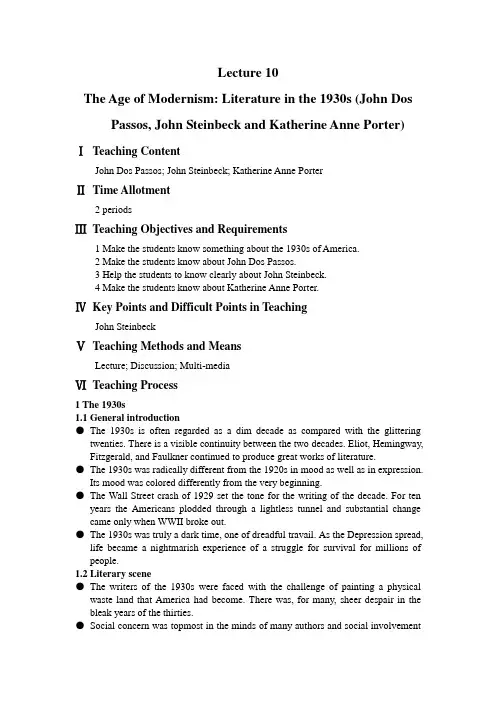
Lecture 10The Age of Modernism: Literature in the 1930s (John Dos Passos, John Steinbeck and Katherine Anne Porter)ⅠTeaching ContentJohn Dos Passos; John Steinbeck; Katherine Anne PorterⅡTime Allotment2 periodsⅢTeaching Objectives and Requirements1 Make the students know something about the 1930s of America.2 Make the students know about John Dos Passos.3 Help the students to know clearly about John Steinbeck.4 Make the students know about Katherine Anne Porter.ⅣKey Points and Difficult Points in TeachingJohn SteinbeckⅤTeaching Methods and MeansLecture; Discussion; Multi-mediaⅥTeaching Process1 The 1930s1.1 General introduction●The 1930s is often regarded as a dim decade as compared with the glitteringtwenties. There is a visible continuity between the two decades. Eliot, Hemingway, Fitzgerald, and Faulkner continued to produce great works of literature.●The 1930s was radically different from the 1920s in mood as well as in expression.Its mood was colored differently from the very beginning.●The Wall Street crash of 1929 set the tone for the writing of the decade. For tenyears the Americans plodded through a lightless tunnel and substantial change came only when WWII broke out.●The 1930s was truly a dark time, one of dreadful travail. As the Depression spread,life became a nightmarish experience of a struggle for survival for millions of people.1.2 Literary scene●The writers of the 1930s were faced with the challenge of painting a physicalwaste land that America had become. There was, for many, sheer despair in the bleak years of the thirties.●Social concern was topmost in the minds of many authors and social involvementwas to be the major feature of the literature of the thirties. The naturalistic rhetoric was brought about a revival. In addition, the writers of the 1930s responded to the turbulence of their times very well. Literary expression in the period was abundant and forceful.●The 1930s was a great age of fiction. (P256) The two major authors who becamedominant figures in fiction were John Dos Passos and John Steinbeck. Dos Passos’U. S. A. and Steinbeck’s The Grapes of Wrath, along with their works and those of other writers offer an authentic account of the American experience in the debilitating years of the Depression. (P256-257) There were young novelists such as James T. Farrell, John O’Hara, and Erskine Caldwell who poured out their torrents of anger and protest in their left-oriented works.●The drama of the 1930s is rich and varied. It is true that no figure comparable toO’Neill appeared, but many people of talent tried to enrich the stage with their plays.●The 1930s was not very good for poetry. (P258)2 John Dos Passos (1896-1970)In a sense the thirties can be called the decade of John Dos Passos. He was the leading naturalist of the Depression, and his masterwork, U. S. A., was probably the best work that came out of the period. John Dos Passos was a spectacular phenomenon in the twentieth-century literary history of the United States.2.1 Works●TrilogiesU. S. A. (1938): The 42nd Parallel (1930), 1919 (1932) and The Big Money (1936) District of Columbia(1952):Adventures of a Young Man(1939), Number One, (1943) and The Grand Design (1949)—chronicles Dos Passos’ further disillusion with the labour movement and radical politics●Novels:One Man’s Initiation (1920)Three Soldiers (1921)Manhattan Transfer (1925)Chosen Country (1951)Midcentury (1961)●PlaysThe Garbage Man (1926)Airways (1928)Fortune Heights (1934)●A biographyThe Head and Heart of Thomas Jefferson (1954)●An autobiographyThe Best of Times: An Informal Memoir (1966)2.2 U. S. A.●It belongs to that category of fiction North Frye call “anatomy”. (P261-263)●In U. S. A.,Dos Passos developed the experimental literary devices where thenarratives intersect and continue from one novel to the next. The devices includedwhat became known as the “Newsreels”(impressionistic collections of slogans, popular song lyrics, newspaper headlines and extracts from political speeches), the “Biographies”, and the “Camera Eye”.●U. S. A. is an organic whole, every bit as well organized as The Waste Land andThe Cantos.3 John Steinbeck (1902-1968)3.1 General introduction●John Steinbeck was awarded the Nobel Prize for Literature in 1962“...for hisrealistic as well as imaginative writings, distinguished by a sympathetic humor and a keen social perception.”●Throughout his life John Steinbeck remained a private person who shunnedpublicity.●His Nobel Prize Acceptance Speech is as follows:“Literature is as old as speech. It grew out of human need for it and it has not changed except to become more needed. The skalds, the bards, the writers are not separate and exclusive. From the beginning, their functions, their duties, their responsibilities have been decreed by our species...the writer is delegated to declare and to celebrate man’s proven capacity for greatness of heart and spirit - for gallantry in defeat, for courage, compassion and love. In the endless war against weakness and despair, these are the bright rally flags of hope and of emulation. I hold that a writer who does not passionately believe in the perfectibility of man has no dedication nor any membership in literature.”3.2 Works●Cup of Gold (1929) (the first novel)●The Pastures of Heaven(1932)●To a God Unknown(1933)●Tortilla Flat(1935): a novel about Monterey, brought him national recognition ●In Dubious Battle (1935),●Of Mice and Men (1937)●The Long Valley (1938)●The Grapes of Wrath (1939): best-known novel●The Moon is Down(1942): a novel about the resistance in Norway to the Nazioccupation.●Cannery Row (1945)●The Pearl(1947)●A Russian Journal (1948)●Burning Bright (1950)●East of Eden (1952)●Sweet Thursday (1954)●The Short Reign of Pippin IV (1957)●Once There Was a War (1958)●The Winter of Our Discount (1961)3.3 Discussion of The Grapes of Wrath (P265-268)●The title of the book comes from “The Battle Hymn of the Republic,” a war songof the Civil War.●It is a story of the migration of agricultural workers from the dust bowl ofOklahoma to California.●It is a crisis novel, full of bitterness and pain but not exactly despair.●It is Steinbeck’s clear expression of sympathy with the dispossessed and thewretched. (P266-268)4 Katherine Anne Porter●Was born in Indian Creek Texas●Began her life as a news reporter and sometimes as an actress and ballad singertravelling through the south●Later stayed in Europe and Mexico which proved very valuable for her writing●Was basically a short-story writer●Her famous short fiction includes “The Flowering Judas”and “The Jilting ofGranny Weatherall,”(a rich and complex story, more than one interpretation, revealing the Exquisiteness of Katherine Ann Porter’s artistic imagination) both collected in Flowering Judas(1930), making her one of the finest short story writer of a high order●Her Pale Horse, Pale Rider (1939) and Learning Tower and Other Stories (1944)reinforced her reputation●Her Collected Stories (1965) won her both a Pulitzer Prize and a National BookAward.●Her writings, especially her short fiction, have been well anthologized and offeredas “standard fare” for the college classroom.ⅦReflection Questions and Assignments1 Read The Grapes of Wrath and make comments from one or two aspects.2 Pre-read Chapter 19 American Drama in the textbook by Chang Yaoxin.ⅧMajor ReferencesEdward by Sculley Bradley. The American Tradition in Literature. Random House Inc., 1956.James D. Hart. The Oxford Companion to American Literature. 北京:外语教学与研究出版社,1995.常耀信.《美国文学简史》. 天津:南开大学出版社,2003.常耀信.《漫话英美文学》. 天津:南开大学出版社,2004.董衡巽. 《美国文学简史》(修订本). 北京:人民文学出版社,2003.李公昭.《20世纪美国文学导论》. 西安:西安交通大学出版社,2000.刘洊波. 《英美文学史及作品选读》. 北京:高等教育出版社,2001.钱青等. 《美国文学名著精选》(上,下). 北京:商务印书馆,1995.陶洁. 《美国文学选读》(第二版). 北京:高等教育出版社,2005.吴伟仁. 《美国文学史及选读》(第一、二册). 北京:外语教学与研究出版社,1990.吴定柏. 《美国文学大纲》.上海:上海外语教育出版社,1998.杨岂深,龙文佩. 《美国文学选读》. 上海:译文出版社,1985.张伯香. 《英美文学选读》北京: 外语教学与研究出版社,1998.张冲. 《新编美国文学史》(第一卷). 上海:上海外语教育出版社,2000. 左金梅.《美国文学》. 青岛:青岛海洋出版社, 2000.。
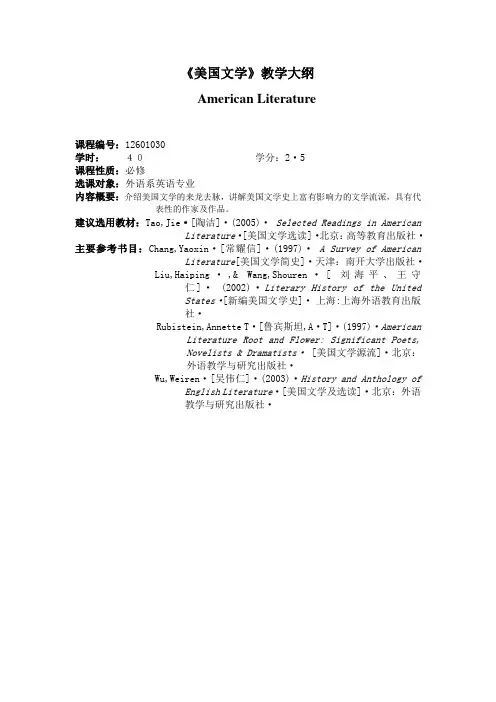
《美国文学》教学大纲American Literature课程编号:12601030学时:40学分:2·5课程性质:必修选课对象:外语系英语专业内容概要:介绍美国文学的来龙去脉,讲解美国文学史上富有影响力的文学流派,具有代表性的作家及作品。
建议选用教材:Tao,Jie·[陶洁]·(2005)·Selected Readings in AmericanLiterature·[美国文学选读]·北京:高等教育出版社·主要参考书目:Chang,Yaoxin·[常耀信]·(1997)· A Survey of AmericanLiterature[美国文学简史]·天津:南开大学出版社·Liu,Haiping·,& Wang,Shouren·[ 刘海平、王守仁]·(2002)·Literary History of the UnitedStates·[新编美国文学史]·上海:上海外语教育出版社·Rubistein,Annette T·[鲁宾斯坦,A·T]·(1997)·AmericanLiterature Root and Flower: Significant Poets,Novelists & Dramatists· [美国文学源流]·北京:外语教学与研究出版社·Wu,Weiren·[吴伟仁]·(2003)·History and Anthology ofEnglish Literature·[美国文学及选读]·北京:外语教学与研究出版社·《美国文学》教学大纲学时:40 学分:2·5一、课程的目的及任务本课程是英语专业高年级学生提高英语语言水平和文化素质的重要课程。
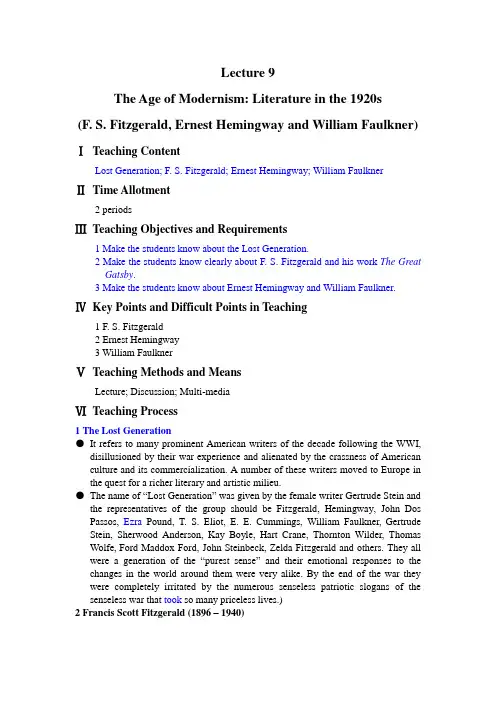
Lecture 9The Age of Modernism: Literature in the 1920s (F. S. Fitzgerald, Ernest Hemingway and William Faulkner) ⅠTeaching ContentLost Generation; F. S. Fitzgerald; Ernest Hemingway; William FaulknerⅡTime Allotment2 periodsⅢTeaching Objectives and Requirements1 Make the students know about the Lost Generation.2 Make the students know clearly about F. S. Fitzgerald and his work The GreatGatsby.3 Make the students know about Ernest Hemingway and William Faulkner.ⅣKey Points and Difficult Points in Teaching1 F. S. Fitzgerald2 Ernest Hemingway3 William FaulknerⅤTeaching Methods and MeansLecture; Discussion; Multi-mediaⅥTeaching Process1 The Lost Generation●It refers to many prominent American writers of the decade following the WWI,disillusioned by their war experience and alienated by the crassness of American culture and its commercialization. A number of these writers moved to Europe in the quest for a richer literary and artistic milieu.●The name of ―Lost Generation‖ was given by the female writer Gertrude Stein andthe representatives of the group should be Fitzgerald, Hemingway, John Dos Passos, Ezra Pound,T. S. Eliot, E. E. Cummings,William Faulkner,Gertrude Stein, Sherwood Anderson, Kay Boyle, Hart Crane, Thornton Wilder, Thomas Wolfe,Ford Maddox Ford, John Steinbeck, Zelda Fitzgerald and others. They all were a generation of the ―purest sense‖and their emotional responses to the changes in the world around them were very alike. By the end of the war they were completely irritated by the numerous senseless patriotic slogans of the senseless war that took so many priceless lives.)2 Francis Scott Fitzgerald (1896 – 1940)(He has been an outstanding novelist in his life time and admired by lots of people.He was once an idol signifying success, wealth, beauty and youth. However, his life was not as happy as the public imagined. He never failed to remain detached and foresee the failure and tragedy of the ―Dollar Decade‖. He is the spokesman of ―the roaring 1920s‖, ―the Jazz Age‖—―Inside he knew it well, outside he saw it ironically.‖)2.1 Works●Novels◆―This Side of Paradise (life in Princeton, frustration of young men):representing the triumph of matter over form◆―The Beautiful and the Damned‖ (love story with Zelda)◆―The Great Gatsby‖ (masterpiece)◆―Tender is the Night‖: seeking to trace the moral doom of its protagonist to thesapping influence of wealth and portraying an American dying, in bar-room brawls and decadence, of spiritual sterility and meaninglessness which characterized the times.◆―The Last Tycoon‖(unfinished): the tragic story of a man who begins torealize all the show of life●Short story collection◆―The Flappers and Philosophers‖(flappers: fashionable and unconventionalyoung woman of the 1920s): representing the triumph of form over matter◆―Tales of the Jazz Age‖ : a legend of ―Americans adolescence before pain setin‖(The 1920s was called ―the Jazz Age‖: a time marked by frivolity, carelessness, hedonism and excitement in the life of the flaming youth.Because of this book; Fitzgerald became ―the angel of the twenties‖)◆―All the Sad Young Man‖◆―Taps at Reveille‖2.2 His ThemeLove and money, life of upper class young generation, the breaking up of American dream, illusion and disillusion●Money brought only tragedy and remorse. In his best novels, he both condemnedand pitied the rich. Fitzgerald dealt with most cleverly with the double theme of love and money. He understood the corrupting relationship between the two better than any other American novelist. He also understood, from his own experience, the constant need for more money which drove these men and women to unscrupulousness.●He did not like the rich whereas he wanted to be rich. He resented theirundeserved privileges, their vulgarity, and their secret belief in their own superiority. He was for that the rich boys could buy more than luxuries—they could attract the affection of any girl they wanted. He believed that the wealthy class corrupted the whole of American society. He wrote from true experience, for he himself was fatally attracted to it. A deep attitude of morality underlies his stories.2.3 His Style●He is a great stylist in American literature. His style, closely related to his themes,is explicit and chilly. His accurate dialogues, his careful observation of mannerism, styles, models and attitudes provide the reader with a vivid sense of reality.●The accurate details, the completely original diction and metaphors, the boldimpressionistic and colorful quality have all proved his consummate artistry.2.4 Discussion of The Great Gatsby●Setting: 1920s; New York City (signifying the materialized American society)●Theme: disillusionment of American Dream in the materialized America●Point of view: first-person point view; using the ―dramatic narrator‖ (means thenarrator is also a character in the novel)Nick Carraway is a delicate designed character. He is related with all the three groups of characters in the novel. He is a reliable person and makes no quick judgments. Employing Nick as the narrator makes the novel have a clear clue and creates the effects of suspense in the most parts of the novel.●Characters◆Nick Carraway: the narrator, rational, mild, understanding, reserved◆Jay Gatsby: innocent (romantic imagination of love, believing money’s power)◆Daisy Buchanan: shallow, selfish, strong desire for extravagant life (comparethe character with Catherine Earnshaw in Wuthering Heights)◆Tom Buchanan: selfish, proud, false, no virtue at all◆Myrtle Wilson: from the lower class, energetic, crude●SymbolismIn the textbook, you can find the novel is called ―a culture allegory‖(P223) because of the use of symbolism in the novel.◆First, think about what the characters in the novel signify.Gatsby: the country’s historyDaisy: seemingly beautiful American DreamTom: commercialization which brought the country only moral depravityNick: hope of the country◆Then, in the novel, if you think about the details you may find more interestingsymbols. For example: why the heroine in the novel called Daisy? Why she always appeared with the color of white? (Daisy在英语中是雏菊的意思,是一种在北美很常见的花。
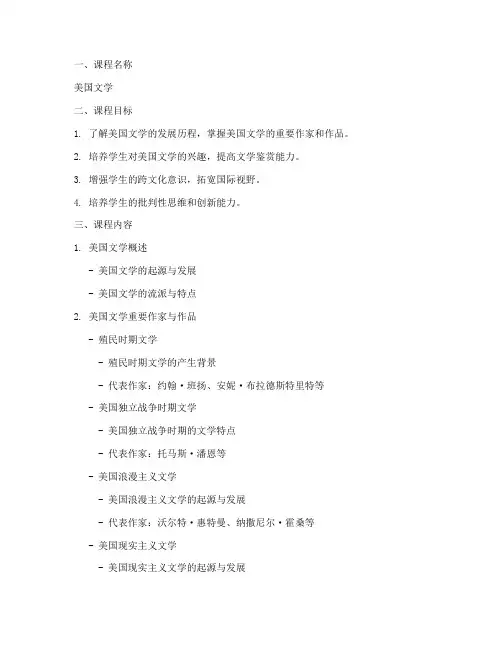
一、课程名称美国文学二、课程目标1. 了解美国文学的发展历程,掌握美国文学的重要作家和作品。
2. 培养学生对美国文学的兴趣,提高文学鉴赏能力。
3. 增强学生的跨文化意识,拓宽国际视野。
4. 培养学生的批判性思维和创新能力。
三、课程内容1. 美国文学概述- 美国文学的起源与发展- 美国文学的流派与特点2. 美国文学重要作家与作品- 殖民时期文学- 殖民时期文学的产生背景- 代表作家:约翰·班扬、安妮·布拉德斯特里特等- 美国独立战争时期文学- 美国独立战争时期的文学特点- 代表作家:托马斯·潘恩等- 美国浪漫主义文学- 美国浪漫主义文学的起源与发展- 代表作家:沃尔特·惠特曼、纳撒尼尔·霍桑等- 美国现实主义文学- 美国现实主义文学的起源与发展- 代表作家:马克·吐温、亨利·詹姆斯等- 美国现代主义文学- 美国现代主义文学的起源与发展- 代表作家:欧内斯特·海明威、弗朗西斯·斯科特·菲茨杰拉德等 - 美国当代文学- 美国当代文学的起源与发展- 代表作家:托妮·莫里森、乔伊斯·卡罗尔·欧茨等3. 美国文学与文化- 美国文学与宗教- 美国文学与社会- 美国文学与种族- 美国文学与性别四、教学方法1. 讲授法:系统讲解美国文学的发展历程、重要作家与作品、文化背景等。
2. 讨论法:组织学生进行课堂讨论,提高学生的批判性思维和创新能力。
3. 案例分析法:选取具有代表性的作品,引导学生进行深入分析。
4. 角色扮演法:让学生扮演作品中的角色,提高学生的文学鉴赏能力。
5. 翻译与写作:让学生翻译美国文学作品,提高学生的语言表达能力。
五、教学进度安排1. 第1-2周:美国文学概述2. 第3-4周:殖民时期文学3. 第5-6周:美国独立战争时期文学4. 第7-8周:美国浪漫主义文学5. 第9-10周:美国现实主义文学6. 第11-12周:美国现代主义文学7. 第13-14周:美国当代文学8. 第15-16周:美国文学与文化六、考核方式1. 课堂参与:占总成绩的30%2. 课堂讨论:占总成绩的20%3. 期末论文:占总成绩的40%4. 平时作业:占总成绩的10%七、教学资源1. 教材:《美国文学史》2. 教学课件3. 美国文学作品选集4. 网络资源通过本课程的学习,使学生全面了解美国文学的发展历程,提高文学鉴赏能力,拓宽国际视野,为今后的学术研究和文学创作打下坚实基础。
备课本教研室:文学教研室课程名称:美国文学史及选读任课教师:**德州学院外语系美国文学史及选读课程的教育目标:通过教学,使学生掌握美国文学的发展史及各阶段具有代表性的主要作家及其作品的主要特色,具备一定的分析鉴赏英语文学作品的能力,帮助培养学生的英语思维能力,提高英语整体水平。
课程的基本要求:要求学生有目的、较系统地了解和掌握美国文学的发展史及各阶段具有代表性的主要作家及其作品的主要特色。
课程的重点与难点:对具有代表性的作家的评价,对著名的美国小说和诗歌的分析、鉴赏及评价。
主要参考书目《美国文学简史》(第二版)常耀信南开大学出版社2004《美国文学选读》李宜燮南开大学出版社2000《牛津文学术语辞典》上海外语教育出版社2000《美国文学大纲》吴定柏上海外语教育出版社1998Introduction1.教学的目的和要求:简述美国文学史,包括美国文学史的5个主要阶段,每个阶段的起止时间,主要特点及代表作家,要求学生了解美国文学史概况2.教学重点:美国文学史的五个阶段及起止时间3.教学难点:各个阶段的主要特点4.教学内容Am literature is one lf the youngest national literature in the world. It became a colony of Britain in the early 17th century. And the American Independence War stretched from 1776 to 1783. The short history can be divided into several stages:• 1.the colonial period•It stretched roughly from the settlement of Am in the early 17th C through the end of the 18th. The first permanent settlement in America was established by English in 1607.(A group of people was sent by the English king James I to hunt for gold. They arrived at Virginia in 1607.They named the James River and build the James town.) Here the major topic will be about Am Puritanism .• 2.the Romantic Period•It covers the first half of the 19th C, which is a period following the national political independence. Around 1840s arose the culmination of the RomanticPeriod---New England Transcendentalism(1836-1855) .• 3.the Age of Realism•It was after the civil war (1861-1865) till the end of the 19th century, covering the latter half of the 19th C. The civil war brought the Romantic period to an end.4.Naturalism(the last decade of the 19th c)•In the last decade of the 19thc, the age of naturalism came into being. Naturalists saw man’s life as governed by two forces---- heredity & environment.5.Modernism•In the decade of the 1920s,there came the age of modernism. (here are many eminent writers in this period, such as T.S Eliot, Earnest Hemingway, William Faulkner, etc.)6.思考题:简介美国文学史Chapter I Literature of Colonial America1.教学的目的和要求:介绍对美国文学及美国文化影响重大的清教主义,要求学生理解清教主义的教义,掌握清教主义对美国文学的影响,,殖民时代的主要作家及启蒙时代的特点2.教学重点:清教主义对美国文学的影响3.教学难点:清教主义的教义,爱德华兹和富兰克林各自的哲学思想4.教学内容•I American Puritanism1.origin of PuritanIn the mediaeval Europe, there was widespread religious revolution. In the 16th C, the English King Henry VIII(At that time ,the Catholics were not allowed to divorce unless they have the Pope’s permission. Henry VIII wanted to divorce his wife because she couldn’t bear him a son. But the Pope didn’t allow him to divorce because his wife is the Pope’s niece. Henry VIII became very dissatisfied with the Pope, so he )broke away from the Roman Catholic Church & established the Church of England. But there was no radical difference between the doctrines of theChurch of England and the Catholic Church. A group of people thought the Church of England was too Catholic and wanted to purify the church. Then came the name Puritans…Of course they had different religious belief from that of the Catholic Church.2.Puritanism---based on Calvinism•1)predestination: God’s electPuritans believed they are predestined before they were born.Nothing or no good work can change their fate.They believed the success of one’s business is the sign to show he is the God’s elect. So the Puritans works very hard, spend very little and invest more for the future business. They lived a very frugal life. This is their ethics.•2)original sin and total depravityMan is born sinful. This determine some puritans pessimisitic attitude toward life. •3)limited atonement (the salvation of a selected few)•4)theocracyThey combined state with religion. Their government is at least not a liberal one. •(The Puritans established Am tradition---intolerant moralism. They strictly punished drunks, adultery & heretics.Puritans changed gradually due to the severity of frontier environment.Puritannism & ConfucianismConfucianism (修身齐家治国平天下) )3.Influence on Am literature•1)its optimismAmerican literature was from the outset conditioned by the Puritan heritage. It can be said American literature is bases on the Biblical myth of the Garden of Eden.(Adam and Eve used to live a carefree life in the Garden of Eden. lured by the snake, they atethe Forbidden Fruit in the apple tree. A peice of apple choked in Adam’s throat , then came Adam’s apple. After knowing the truth, God became very angry and drove them all out of the Garden of Eden. The snake used to walk like man but after that the God force him to crawl. Then man was forced to suffer the labor to keep the whole family and Woman was forced to suffer the agony of baby bearing.) After that, man have an illusion to restore the paradise. The puritans, after arriving at America, believeing that God must have sent them to this new land to restore the lost paradise , to build the wilderness into a new Garden of Eden. Fired with such a strong sense of mission, they treated life with a tremendous amount of optimism. The optimistic Puritans has exerted a great influence on American literature,•2)Puritan’s metaphorical mode of perception changed gradually into a literary symbolismII Colonial LiteratureAmerican colonial literature is neither real literature nor Americanwhy?1.Diaries,histories,journals,letters,etc. personal literature in various forms2.Colonial Literature is mainly English literature tradition imitated & transplanted. Anne BradstreetEdward TaylorThey can be called servants of God. Their writings served either God or colonial expansion.Some other colonial writers wrote for civil and religious freedom, and some wrote for America shaking off the fetters of the savage British colonial rule.Roger WilliamsJohn WoolmanThomas PaineOne of most important American prose writers of the 18th Century. He wrote a number of revolutionary works to attack British colonial rule. 1776, he wrote “Common Sense”, which greatly encouraged the painfully fighting people.After the war, he participated in the French Revolution and wrote“The Rights of Man” and “The Age of Reason” to spread the ideals of the French revolution among the people.Philip FreneauHe is the most important poet of the 18th Century, a notable representative of dawning nationalism in American literature.“The Rising Gl ory of America” is a good example.He is the transitional role b/w the neoclassism of the 18th C and the Romanticism of the 19th C. This is clearly manifested in his “The Indian burying Ground” and “The Wild Honey Suckle”III Edwards and Franklin—two representatives of the age of Enlightenment(of the 18th Century)•(The 18th C Am history witnessed two great revolutions: one was Am IndependenceWar, the other was Enlightenment. Enlightenment was several decades earlier than the Revolution, and it helped paved the path for the Independence war in people’s war. (P.28))i.Background: the age of Enlightenment•Toward the latter part of the 17th century, with Newton’s laws of motion and the idea of gravity, a completely new view of the universe came into being. In the minds of some thinking people, the universe became something mechanical subject to certain physical laws instead of to the supervision of God. This brought about a whole set of new ideas, among which was deism(自然神论)。
课程名称:美国文学史授课对象:大学本科二年级课时安排:2课时教学目标:1. 了解殖民地时期美国文学产生的社会及文化背景。
2. 掌握新英格兰文学的特点和代表作品。
3. 深入理解清教主义思想对文学创作的影响。
4. 分析安妮·布拉德斯特里特和爱德华·泰勒的诗歌创作。
教学重点:1. 殖民地时期美国文学的社会及文化背景。
2. 新英格兰文学的特点和代表作品。
3. 清教主义思想对文学创作的影响。
教学难点:1. 清教主义思想在文学作品中的具体体现。
2. 安妮·布拉德斯特里特和爱德华·泰勒诗歌的鉴赏。
教学过程:一、导入1. 介绍殖民地时期美国文学的历史背景,引导学生了解殖民时期美国文学的重要性。
2. 提出问题:殖民时期美国文学产生的社会及文化背景有哪些?二、讲授新课1. 殖民地时期美国文学产生的社会及文化背景- 殖民地时期的地理环境、宗教信仰、文化传承等因素对文学创作的影响。
- 殖民地时期美国文学的独特性及其与欧洲文学的联系与区别。
2. 新英格兰文学- 新英格兰文学的特点:清教主义思想、宗教色彩浓厚、语言简练、注重道德教化。
- 代表作品:《弗吉尼亚日记》、《新英格兰诗集》等。
3. 清教主义思想对文学创作的影响- 清教主义思想对作家价值观、人生观的影响。
- 清教主义思想在文学作品中的具体体现。
4. 安妮·布拉德斯特里特和爱德华·泰勒的诗歌创作- 分析安妮·布拉德斯特里特的诗歌《致上帝的祈祷》和《致儿子》。
- 分析爱德华·泰勒的诗歌《基督徒的忧愁》。
三、课堂讨论1. 结合所学内容,讨论清教主义思想对殖民地时期美国文学的影响。
2. 分析安妮·布拉德斯特里特和爱德华·泰勒诗歌的异同。
四、总结1. 总结殖民地时期美国文学的特点及代表作品。
2. 强调清教主义思想对文学创作的影响。
五、课后作业1. 阅读安妮·布拉德斯特里特和爱德华·泰勒的诗歌,撰写一篇鉴赏文章。
《美国文学史及作品选读》教学大纲一、课程说明1. 课程代码:1070138312. 课程中文名称:美国文学史及作品选读3. 课程英文名称:History and Selected Readings of American Literature4. 课程总学时数:265. 课程学分数: 1.56. 授课对象:英语专业本科学生7. 本课程的性质、地位和作用本课程为面向英语专业高年级(三年级)学生开设的一门专业选修课,在学科体系中居重要地位。
要求学生以先修英语阅读、综合英语、英美文化和英美概况等课程为基础。
通过教学,使学生对美国文学有一个概观了解,同时初步培养学生对美国文学作品的鉴赏能力,增强学生对西方文学及文化的了解。
该课程有助于增强学生的语言基本功,丰富学生的人文知识、充实学生的文化修养,提高学生的精神素质。
二、教学基本要求1. 本课程的目的、任务美国文学史及文学作品包含着历史的记忆和哲学的睿智,是英语语言艺术的结晶。
本课程旨在介绍美国文学各个时期的主要文化思潮,文学流派,主要作家及其代表作,使学生对美国文学的发展脉络有一个大概的了解和认识,提高他们对文学作品的阅读鉴赏能力,并能掌握文学批评的基本知识和方法。
要求学生在阅读和分析美国文学作品的基础上了解美国的历史、社会、政治等方面的情况及传统,促进学生对西方文学及文化的了解,提高学生对文化差异的敏感性、宽容性,培养学生对作品的洞察批判能力,从而丰富提升学生人文素养。
2. 本课程的教学要求了解美国文学的发展概况,熟悉发展过程中出现的历史事件,文学思潮,文学流派;熟悉具体作家的文学生涯,创作思想,艺术特色和所属流派;能读懂代表作家的经典作品,并能分析评介作品的主题思想,人物形象,篇章结构、语言特点、修辞手法、文体风格;能掌握文学批评的基本知识和方法,对重要的文学术语有相当的了解并能在文学批评中加以运用。
重点放在代表作家的经典作品的主题思想、人物形象、文体风格、语言特点及其在文学史上的地位与影响,其中作品的主题思想、人物形象、文体风格及语言特点为难点。
《美国文学史及作品选读》课程教学大纲课程编码:30613010 学分: 4 总学时:68说明【课程性质】《美国文学史及作品选读》是全日制大学本科教育英语专业高年级开设的专业必修课。
【教学目的】了解美国文学的发展和成就,掌握文学理论和文学批评的基本知识和方法,提高理解、鉴赏英美文学原著的能力和人文素质。
【教学任务】以美国文学史为线索,介绍各个时期代表作家、作品,及其创作思想、主题、题材和风格,使学生对美国文学形成与发展的全貌有大致的了解,能够将文学作品与特定的历史时期相联系,掌握正确评价、分析文学作品的基本知识和方法,培养和提高其阅读能力、语言能力及文学鉴赏能力。
【教学内容】文学基础知识介绍,殖民时期的美国文学,启蒙主义时期的美国文学,浪漫主义时期的美国文学,现实主义时期的文学【教学原则和方法】教学原则:以主要作家与作品研究分析为主,以文学史学习为辅;教授文学知识与提高鉴赏能力相结合教学方法:以课堂讲授为主,适当组织课堂讨论,鼓励学生充分利用课外资源进行探索性、研究性学习。
【先修课程要求】美国文学史及作品选读课是英语专业的必修课, 是在完成了精读、泛读、写作等基本技能训练后开设的,旨在加强学生对文学的理解,增强对文学的感性认识,培养文学素养,提高文学鉴赏能力。
【教材与主要参考书】教材:吴伟仁《美国文学史及选读》外语教学与研究出版社,1990年。
参考书:吴定柏《美国文学大纲》上海外语教育出版社, 1905年。
常耀信《美国文学简史》南开大学出版社, 1990年。
胡荫桐《美国文学教程》南开大学出版社, 2001年。
大纲内容第一部分文学基础知识介绍【教学目的和要求】教学目的:了解文学的基本知识教学要求:掌握文学的基本要素【内容提要】第一节文学的定义及研究对象第二节文学的基本要素第三节学习文学的目的和方法第四节美国文学历史简介【教学重点与难点问题】教学重点:文学的基本概念和要素及其区别和联系教学难点:美国文学的形成及发展【复习思考题】1.什么是文学?2.文学的基本分类和要素有哪些?3.美国文学主要分为哪几个发展阶段?第二部分殖民地时期的文学【教学目的和要求】教学目的:介绍殖民地时期的社会及文化背景与新英格兰文学的状况教学要求:理解清教主义思想及其对美国文学的深远影响【内容提要】第一节美国殖民地时期概述一、北美拓殖的开始二、美国清教主义思想三、美国清教主义思想对早期美国文学的影响第二节殖民地时期的代表作家及作品一、安妮•布雷兹特里特(Anne Bradstreet)二、爱德华•泰勒(Edward Taylor)【教学重点与难点问题】教学重点:殖民地时期新英格兰文学的特点教学难点:清教主义思想【复习思考题】殖民时期新英格兰文学的主要特点是什么?第三部分理性和革命时期的文学【教学目的和要求】教学目的:介绍理性和革命时期美国文学产生的社会及文化背景教学要求:掌握理性和革命时期美国文学的形式、特点、代表作家及作品【内容提要】第一节历史背景介绍第二节启蒙运动及其对美国文学的影响第三节理性和革命时期的文学家及代表作品:一、本杰明•富兰克林(Benjamin Franklin)二、托马斯•潘恩(Thomas Paine)三、托马斯•杰弗逊(Thomas Jefferson)四、菲利普•弗瑞诺(Philip Freneau)【教学重点与难点问题】教学重点:理性和革命时期美国文学的主要特征教学难点:本杰明·富兰克林作品反映的思想意识及精神风貌【复习思考题】1.理性和革命时期美国文学主要特征是什么?2.启蒙运动对美国文学有怎样的影响?3.简述富兰克林《自传》的思想内容和文体特征。
闽江学院教案课程名称:主要英语国家文学史及文学作品选读 2 课程代码: 31020022授课专业班级:英语本科, 英语师范, 英语专升本****:***系别:外语系2010年3 月2 日IntroductionTeaching aid tool: a map of early AmericaTeaching aim: the students learn why and how to learn literature course, get the general idea of the colonial America and their literary forms.Key Points: a. learning aim;b. Learning method;c. Colonial American characteristics.I.Introduction of the course1.Why should we learn the course:a.One of the main reasons might be that literature offers a bountiful and extremely varied body of written material, which is “important in the sense that it says something about fundamental human issues and which is enduring rather than ephemeral. Its relevance moves with the passing of time, but seldom disappears completely the Shakespeare plays whose ending were rewritten to conform to late 17th century taste and which were later staged to give maximum prominence to their romantic hero figures are now explored for their psychoanalytic import. In this way, though its meaning does not remain static, a literary work can transcend both time and culture to speak directly to a reader in another country or a different period of history.Literature is authentic material. By that we simply mean that most works ofliterature are not fashioned for the specific purpose of teaching a language.Recent course materials have quite rightly incorporated many authenticsamples of language---for example, travel timetable, city plans, forms,pamphlets, cartoons, advertisements, newspaper or magazine articles.Learners are thus exposed to language that is as genuine and undistorted ascan be managed in the classroom context. In reading literary texts, studentshave also to cope with language intended for native speakers and thus wegain additional familiarity with many different linguistic uses, forms andconventions of the written mode with irony, exposition, argument, narrationand so on.b. Cultural enrichment:For many language learners, more indirect routes to understand a country must be adopted so that they gain an understanding of the way of life of the country: radio programmers, films and videos, newspapers and last, literary works. It is true of course that the “world” of a novel, play, or short story is a created one, yet it offers a full and vivid context in which characters from many social backgrounds can be depicted. A reader can discover their thoughts, feelings, customs, and possessions: what they buy, believe in, fear, enjoy; how they speak and behave closed doors. Reading the literature of a historical period is one of the ways we have to help us imagine what life was like in that other foreign territory. Literature is perhaps best seen as a complement to other materials used to increase the foreign learner’s insight into the country whose language is being learnt.c. language enrichment: we have said that reading literary works exposes the studentto many function of the written language, but what about other linguistic advantages? Language enrichment is one benefit often sought through literature, while there is little a=doubt that extensive reading increases a learner’s receptive vocabulary and facilitates transfer to a more active form of knowledge, it is sometimes objected that literature does not give learners the kind of vocabulary they really need. It may be “authentic” in the sense already mentioned, but the language of literary works is not typical of the language of daily life, nor is it like the language used in learners’textbooks. We would not wish students to think that Elizabeth Berret Brownning’s “How Do I love Thee? Is the kind of utterance normally whispered into a lover’s era nowadays! The objection to literature on the grounds of lexical appropracy has some validity, but it need not be an overriding one if teachers make a judicious choice of the text to be read, considering it as a counterpoise and supplement to other materials.On the positive side, literature provides a rich context in which individual lexical or syntactical items are made more memorable. Reading a substantial and contextual zed body of text, students gain familiarity with many features of the written language ---the formation and function of relines, the variety of possible structures, the different ways of connecting ideas---which broaden and enrich their own writing skills. The extensive reading required in tackling a novel or long play develops the student’s ability to make inferences from linguistic clues, and to deduce meaning from context, both useful tools in reading other sorts of material as well. Literature helps extend the intermediate or advanced learner’s awareness of the range of language itself. Literary language is not always that of daily communication, as we have mentioned, but it is special in its way. It is heightened: sometimes elaborate, sometimes marvelously simply yet, somehow, absolutely “right”.2.What should we learn?History and Anthology of American literature3.Some Literary works:Selected Reading in American Literature 扬岂深Selected Reading in American Literature 陶洁Selected Reading in American Literature 常耀信Contemporary American Literature with Collateral Readings 秦小孟High Lights of American Literature 钱青An Anthology of 20th Century American Fiction 万培德A Survey of American Literature 常耀信20世纪美国文学导论李公昭二十世纪美国文学导读张立新Part I The Literature of Colonial AmericaI.Teaching Time: 2 teaching hours.II.Teaching Aim: through introduction, the students should get an idea about the history and development of American nation and how did the American literature came into being and what is the characteristic of its early literature.III.Teaching method: Teacher’s Presentation.IV.Teaching Tool: multi-medium.V.Key points: the characteristics of early literature.IntroductionI.The native Americans and their culture:Before being explored by European adventurers the American Continent had long been inhabitated by the natives---American Indians. Physical characteristics of the American Indians are mongolocial or a mixture of that with something else. They probably first began coming from Asia to America during the Ice ‘Age,8000-5999 BC. They crossed Berring Strait by raft. Through hundred and thousands of years these earliest inhabitants developed their own civilizations. They learned agriculture, basketry and pottery. The most striking achievements were in agriculture. Maize---“Indian Corn” was developed from a wild grass. The white potato, the cacao bean, tobacco were all developed by Indians. Indians remained in tribe society.II.The historical background of the Colonial Time:1.the first England settlement: Christophe Columbus (1451 hebelieved the world is round, find the route to East by sailing West, heasked the help from Queen of Spain to support him. On Aug. 3. 1492,three small vessels set sail with 100 crews, after several months ofsailing they arrived at Balama Island---San Salvador on Oct. 12.1492. He landed and in March 1493 returned. He had 4 voyages inhis lifetime.2.English settlement:1607 Captain Christopher Newport, three ships --- Chesapeake BayJamestown Mayflower 1620 PlymouthPuritans New England area3.Conflicts with Indians and the founding of 13 colonies.III.The development of Literature:American literature emerged out of obscurity into history only some four centuries ago. It is the newest of the literatures of great nations, yet it is original in many aspects. It is original because it mirrors the history of America, and epitomizes the development of political and economics, social and psychological institutions. It is original because upon it has played most of those great historical forces and factors that have molded the modern world: immigration, nationalism, individualism, imperialism, religion,science, technology and democracy. In addition to its realistic and vividreflection of the madding of the distinctly shaped character of Americanpeople, it is original in variety and cultural colors; such features of Americanliterature may find expression in its products in the colonial period.John Smith a British soldier of fortune“A True Relation of Such Occurrences and Accidents of Note as hathhappened in Virginia”“New England Trials”“The General History of Virginia”Within a few decades a considerable number of learned people, such asPuritan clergymen and governors, produced a considerable body of writing ofhigh literary quality, yet they were not literary people in the professionalsense. Their writing included diaries, travel books, collections of letters,journals, histories, poetry, biographies, autobiographies and prose, to whichthe Puritans contributed much. In addition to being true believers of theirreligious doctrines, the early puritans generally have college education with asound knowledge of the literary classics, and learned much about the basicqualities of literature from the ancient and contemporary authors in the oldcontinent. Such responsible for the two essential characteristics of the earlyAmerican literature: their religious subject and imitation of English literarytraditions.(1)William Bradford (1590-1657)Of Plymouth Plantation(2) John Winthrop (governor of Massachusetts Bay)Journal 1790The History of New England(3) Edward TaylorThe New England Quarterly(4) Cotton MatherMagnolia Christi AmericanaCharacteristics:In spite of the unique features that the colonial men of letters, reflected in their writings, some common characteristic run through almost all the principal works of the major literary figures of the colonial period, which mirrored the nature of colonial American literature and continued to be the subsequent development of American literature and of America itself. Puritanism was central to colonial American literature and its impact could find expression in almost all respects concerning literature. The conviction that all religious progress centered in the individual led colonial writers to make records of his spiritual development in the forms of diary and autobiography: a strenuous self-analysis and ceaseless searching of conscience in the writings of the Puritans was the result of their belief that “election” would show itself in the behavior and in the experiences of the inner life of the individual. In keeping with the beliefthat American literature should concern itself with spiritual and in the experiences of the inner life of the individual. In keeping with the belief that literature should concern with spiritual values, the sermon became the most highly developed and the most popular of Puritan and compact expression, and its avoidance of rhetorical decoration excellently illustrated Puritan aesthetic and moral theories. In accordance with their way of life, the Puritans preferred a style characterized by homeliness of imagery, simplicity of diction and an emphasis on the values most easily recognized by their readers. It is for the same reason that they disliked the sensuous appeal of certain types of imagery and favored the figures and images drawn from the common experiences of the New England settlers.Questions for discussion:1.What were the features of colonial America?2.What were the literary characteristics?3.What was the Puritanism?Reference Books: 1. 《美国文学教程》第一章常曜信2.《美国文学的周期》 E. Spiller3. 《新编美国文学史》第二章刘海平Part II The Literature of Reason and RevolutionI, Teaching time: 2 teaching hoursII.Teaching Aim: the students should know the reason and effect of American Revolution, and the characteristics of the literature. Through learning the selected works, the students get to know the writing style of them.III.Teaching Method: a. presentation, b. analysis of the contexts of the works, c.questions and discussion.IV.Key points: writing style of the prose works.Introduction:I.The Historical Background:a)two revolutions {American RevolutionEnlightenment(1)European’s conflicts in the New Continent;(2)The cause of the Revolution;(3)The procedure of the Revolution;(4)The significance of the Revolution.II.The Development of Literature:(1)prose of Thomas Paine, Franklin and Thomas Jefferson;(2)Poetry of ByrantQuestions for Discussion:(1)What do you know about American Revolution?(2)What do you know about Washinton?(3)What is the main trend of literature?III.Authors and their writings in this period:(1)Benjamin Franklina.his life and works: Benjamin Franklin was a brilliant, industrious and versatile man. Starting as a poor boy in a family of 17 children, he became famous on both sides of the Atlantic as a statesman, scientist and author. Despite his fame, he always remained a man of industry and simple tastes.Franklin’s writings range from informal sermons on thrift to urbane essays. He wrote gracefully as well as clearly with a wit which often gave an edge to his words. Though the style he formed came from imitating two noted English essayists, Addison and Steele, he made it into his own. His most famous work is his Autobiography. Before his autobiography, his “Poor Richard’s Almanac(1733-1758) became popular readings which contain many proverbs like:Early to bed, and early to rise,Makes a man healthy, wealthy and wise.Franklin’s Autobiography is many things. First of all it is an inspiring account of a poor boy’s rise to a high position. Franklin tells his story modestly, omitting some ofhis misdeeds, his errors as being much less than perfect. He is resigned to the fact that his misdeeds will often receive a punishment of one sort or another. Viewing himself with objectivity, Franklin offers his life story as a lesson to others. It is a positive lesson that teaches the reader to live a useful life. In fact the Autobiography is a how-to-do it book, a book on the art of self-improvement.In 1771, while living in England and serving as ambassador for most of the colonies, Franklin began his autobiography as a letter to his son, Willliam. He got as far as the year 1730(including his arrival in Philadelphia) being interrupted by “the affairs of the Revolution”. In 1784, while living at Passy, France, then a suburb of Paris, he extended his Autobiography through 1731. The bulk of the remainder of the work was added in 1788 and the final few pages were written in1790, the year of his death. None of this was published while Franklin lived. Shortly after his death, a French translation of his life to 1731 ( the first two section that Franklin wrote) was published. Though this was soon translated into English and published in London, the “official text did not appear until 1818, as part of the works of Benjamin Franklin,”edited by his grandson William Temple Franklin. The first “complete”Autobiography---with the pages written in 1790---did not appear until 1868, edited by John Bigelow, who had bought Franklin’s original manuscript from a Franklin family the previous year.The Autobiography covers Franklin’s life only until 1757 when he was 51 years old, well before his major accomplishments as a diplomat. The work as a whole was written by a man well beyond the normal age of retirement, yet it is not the less lively for that fact. Franklin’s mastery of a prose style characterized by clarity, concision, flexibility and order was central to his fame as a great man of letters. Such major features of his style was summarized by himself in a short paragraph:The words used should be the most expressive that the language affords, provided that they are the most generally understood. Nothing should be expressed in two words that can as well be expressed in one; that is, no synonyms should be used, or rarely, but the whole should be as short as possible, consistent with clearness: the words should be placed as to agreeable to the ear in reading; summarily, it should be smooth, clear, and short for the contrary qualities are displeasing.(2)Analysis of the Selected part:A.3 paragraphs: a. what interest did Franklin have as a child;a.Being an apprentice to his brother, Franklin began writing;b.Improving argumentation.Summary: Franklin was thirty to knowledge and trying to learn the language with practical methods.B a. the way of learning languages;b.Practice makes perfect;c.Relations to his relatives;d.Learning club.Summary: Franklin was a practical man. In learning languages we know he had a strong endurance and leaver mind.Part III The Literature of RomanticismI.Teaching Time : 8 periods.II.Teaching Aim: the students should know the characteristic of the origin and development of romanticism in American literature. Transcendentalism as a typical American literature trend developed in American land should be mastered. The students should know how to analyze Bryant’s two poems.III.Key Points: characteristic of American romanticism and their writers.Part One: Historical Introduction:We are now dealing with one f the most important periods in the history of American literature, the Romantic period, which stretches from the end of the eighteenth century through the outbreak of the Civil War. Here we see a rising America fast burgeoning into a political, economic and cultural independence it had never known before. Democracy and political equality became the ideals of the new nation. Radical changes came about in the political life of the country. Parties began to squabble and scramble for power, and a new system was in the making. The spread of industrialism, the sudden influx of immigration, and the “pioneers”pushing the frontier further west---all these produced something of an economic boom and, with it, a tremendous sense of optimism and hope among the people. A nation bursting into new life for literary expression. The buoyant mood of the nation and the sprit of the times seem in some measure responsible for the spectacular outburst of romantic feeling in the first half of the nineteenth century. The literary milieu proved fertile and conducive to the imagination as well. Among other things, magazines appeared in ever-increasing numbers, of which The North American Review, The New York Mirror, The American Quarterly Review, The New England Magazine, The Southern Review, The Southern Literary Messenger, The Atlantic Monthly, Harper’s Magazine and Knickerbockers Magazine played an important role in facilitating literary expansion in the country.Foreign influences added incentive to the growth of romanticism in America. The Romantic Movement, which had flourished earlier in the century both in England and Europe, proved to be a decisive influence without which the upsurge of American romanticism would hardly have been possible. Sir Walter Scott, Samuel Taylor Cole ridge, William Wordsworth, Byron, Robert Burns and many other English and European masters of poetry and prose all made a stimulating impact on the different departments of the country’s literature. The influence of Sir Walter Scott was particularly powerful and enduring. His border tales and Waverley romances inspired many American authors such as James Fennimore Cooper with irresistible creative impulses. Scott’s Waverley novels were models for American historical romance, and his The Lady of the Lake, together with Byron’s Oriental romances, helped toward the development of American Indian romance. He was, in a way, responsible for the romantic description of landscape in American literature. The Gothic tradition, and the cult of solitude and of gloom came through interest in the works of writers like Mrs. Radcliff, E.T.A. Hoffman, James Thomson and the “graveyard’poets. Robert Burns and Byron both inspired and spurred the American imagination for lyrics oflove and passion and despair. The impact of Lyrical Ballads of Wordswoth and Coleridge added, to some extent, to the nation’s singing strength. Thus American romanticism was in a way derivative: American romantic writing was some of them modeled on English and European works.On the other hand, American romanticism had distinct features of its own. Different from their European counterparts, American romantics tended to moralize, to edify rather than to entertain. They presented an entirely new experience alien to European culture. The exotic landscape, the frontier life, the westward expansion, the myth of a New Garden of Eden in America, and the Puritan heritage were just a few examples of the native material for an indigenous literature. Evidently, it produced a feeling of “newness” which inspired the romantic imagination.Part II. Writers of the period1.Washington Irving (1783-1859)I.Introduction of his life and works: Washington Irving was the first American writer of imaginative literature to gain international fame. He became, in the words of the English novelist Thakeray, “the first Ambassador whom the new World of letters sent to the old.” Irving was born the youngest of seven children of a precious reader and the author of juvenile poems, plays and essays when he was 16; he began the study of the law for which he had little relish. He preferred instead to pass his time in desultory reading and in the society of literary wits of New York. At 19, he began to contribute a serious of sketches or “letters” on society and the theater to the Morning Chronicle, a New York newspaper. When he was 21, Irving went on a grand tour of Europe. Two years later he returned to New York to be admitted to the bar and to begin the leisurely life of a gentleman lawyer; shortly afterward, Irving started work on what was to be his first literary triumph, his “History of New York (1809) by “Derrick Knickerbockers.”It was an irreverent to spoof of historical scholarship, salted with off-color comments. The book satirized the complacent Dutch burghers of early New York and pointed at the political follies of 19th century America. It also marked the beginning of the “Knickerbockers school” of New York literary satirists including Paulding, Fitzgreen Hallack and Joseph Rodman Drake who took their names and humorous tone from Irving’s knickbocker History and flourished in New York in the first decades of the 19th century.At the end of the war of 1812, Irving was sent to England to supervise the Liverpool Branch of the family firm, but in 1818, as a result of the war and bad management, the firm went bankrupt. Irving was left only with a dislike for the “dirty soul-killing”world of business and a need to find a livelihood. His “History of New York”has earned the magnificent sum of $3000, so he turned to writing and began preparation of “The Sketch Book of Geoffrey Crayon, Gent(1820). It was the first work by an American to receive wide international acclaim and it made Irving a celebrity, praised alike in America and England. In it was the two tales that brought him his most enduring fame. “Rip Van Winckles” and “The Legend of Sleepy Hollow.”With his new literary success, Irving gave up all thought of returning to America and the world of trade or law. He set out to become a professional man of letters. The Sketch Book was soon followed by Bracebridge Hill (1822), a series of sketches onEngland country life. In 1824, he published “Tales of a Traveller”, his first volume of fiction, filled with years of the supernatural and clanking with the ghostly machinery of romantic Gothicism. In 1826 his literary fame earned him appointment as an American diplomatic attaché in Spain and there he gathered material for a biography of Christopher Columbers(1826). He wrote severy such kind of biographies.Irving then returned to England, where he accepted appointment as an American diplomat in London and three years later when he was nearing 50, he returned to the United States after an absence of 17 years. He bought “Sunnyside” his famous home on the Hudson River at Tarrytown and there, except for four years as United States minister to Spain he lived as a country spire, writing a series of histories and biographies.A study of Irving’s works would lead to the conclusion that humor was at the root of almost everything that was significant in them. What was more impressive was that his humor was always well meaning, mild and easy to be accepted. Early in the 19th century when most of the American writers were speaking in the authoritative voice of a gentleman who seems to be superior in maturity, knowledge, sense, and good taste, and when the majority of American periodicals depended heavily on a broad, explosive humor and sarcasm that gradually vulgarized the periodical essay tradition, Irving’s humor did much to cultivate a new literary taste.The style of Irving’s work is characterized by simplicity, poise and ease flow. Unlike the tightly structured stories of Poe and Hawthorne, the tastes of Irving lie in his literary innovations and transitional role in the development of American literature. III.Analysis of the tale:1.Plot structure of action:e.Exposition: time, place, persons preliminary condition of affairs;f.DevelopmentConflicts Crane to Brom Bones; Crane to the girl; Crane to farmers;Crane to ghost;g.Summary ----pumpkin, Bones marries the girl, some still believe inghosts,h.Setting -----i.StyleQuestions for discussion:1.What is the plot of the story?2.How did the conflict develop in the story?3.What is the function of the setting?4.What is the style of the story?Homework: Read the story Rip Van Winkle.2.James Fennimore Cooper (1789-1851)(a)Introduction: Cooper never saw the frontier. The advanced line of settlement that moved westward from the Atlantic had passed beyond Cooperstown, New York before his birth and throughout his life; he never traveled farther west than Michigan. Yet his writing helped create a mythical west that transcended the reality of life on thefrontier, and in his greatest character ---Natty Bumppo, or “Leatherstocking”---Cooper created an archetypal western hero whose many literary descendants range from the cowboys of popular fiction and the movies to the hero of Melville, Twain and Faulkner.James Cooper was born in Burlington, New Jersey. When he was thirteen months old, he was taken with his family to a small wildness settlement on Lake Otsego, 150 miles north of New York City. The village was named Cooperstown after his father, William Cooper, a rich member of the landed gentry who had acquired vast tracts of land in New York State following the American Revolution. James Cooper was raised in the rural family “Manor House”, and he roamed the edge of a wildness that stretched a thousand miles to the Mississippi. Although he saw the white hunters and the numerous wagon trains of settlers that passed through Cooperstown on their way west, he saw little of the once numerous reedmen of the eastern forests. Later in life he acknowledged, “ I was never among the Indians. All that I know of them is from reading and from hearing my father speak of them.”When Cooper was fourteen, he entered Yale, but in his junior years after a series of undergraduate brawls and pranks he was expelled and was sent to sea as a common sailor on an Atlantic merchant ship. In 1808, he became a mild shipman in the U.S navy and served on Lawrence. In 1811, after the death of his father left him an inheritance of $50,000, Cooper resigned from the navy. He then married and began the free-spending life of a wealth gentleman. By 1819, his inheritance was gone and he was heavily in debt. To regain his fortunes, he speculated in land, invested in a frontier store and a whaling ship, and in 1820 he began writing the fiction that eventually brought him wealth and worldly fame.According to tradition, he once tossed aside a popular-sentimental novel with the comment that he could do better himself. When his family challenged him to fulfill his boast he wrote a tale that he quickly recognized as a botch and destroyed. His second attempt was Precaution (1820). It was a full-length novel of English life, written in imitation of Jane Austin and filled with the conventional sentimentality of the day’s best sellers. Precaution was dull, and a financial failure, but it brought Cooper recognition and helped prepare the way for his next work. The Spy (1821), a novel of the American Revolution. The Spy appealed to patriotic American hungry for exciting fiction that dealt with American scenes and events. It soon went through three editions; it was translated into several European languages and turned into a stage play. And it started Cooper on his career as the first eminent American novelist.Two years later Cooper published The Pioneers (1823), a romance of the American frontier that was an immediate best seller. It was the first of the “Leatherstocking Tales,”five novels of the life of Natty Bumppo. They included “The Last of Mohicans”(1826), The Prairie(1927), The Pathfinder(1840), and the Deerslayer(1841). Following his success with The Pioneer, Cooper drew upon his own experiences and wrote The Pilot(1841) the first of eleven novels of the sea that he wrote over a period of three decades.In 1926, with his financial burdens eased by the profits from his writing Cooper left America to live abroad, partly to escape his remaining debts and partly to experience。